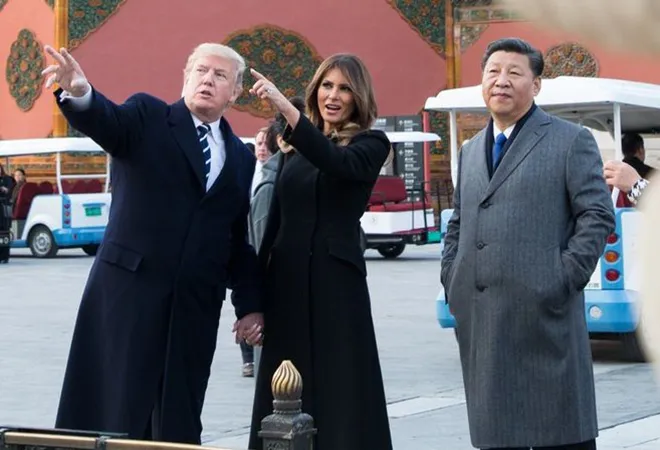
Will US technology might hit Chinese hardware expertise? Will China’s retaliatory tariff on US farm products help Indian agriculture exports? As the impending US-China trade war escalates, there is a lot of shadow boxing and re-negotiation that gives nations like India a chance to enter difficult foreign markets.
During his high pitched election campaign of 2016, President Donald Trump had promised a punitive 45% tariff against Chinese imports. “The only power that we have with China is massive trade,” said the Republican nominee, promising to correct the humongous adverse trade balance that exceeded over $300 billion each year. He also promised tariffs against China for undervaluing its currency and disrespecting copyright laws.
The initial tussle and strategic positions
But President Trump did not act with haste when he came to power. Instead, he used persuasion to correct the trade imbalance with America’s biggest trade partner, China. Instead of resorting to slam bang tactics, he proceeded with caution. A few months after assuming office, he started investigations on the effect of imports of steel and aluminium on US national security under section 232. This was a long winding process with public hearings and evidence collection, ensuring effectively that the US decision could not be reversed under the WTO.
Even before the US could impose tariffs based on the investigation, China warned the US that any action by the US would result in tit-for-tat action. A statement issued in December 2017 said that China would hit back where it hurt the most. In almost a simultaneous action, China decided to upgrade the quality norms of US Soy imported into China. The biggest global importer of Soy insisted that foreign material content in US imports be brought down from 2% to 1%. China imports 100 million metric tonnes of Soybean annually, most of it from the US, which acts as a cheap protein substitute and a binder material for its massive processed foods industries. The total US exports of Soy exceeded $ 22 billion in the year 2017.
Even before the US could impose tariffs based on the investigation, China warned the US that any action by the US would result in tit-for-tat action. A statement issued in December 2017 said that China would hit back where it hurt the most.
Raising the quality norms made US Soy more expensive. The US exported 36.2 million metric tonnes to China alone in the year 2017 at a value of $12 billion. But in January 2018, US exports of Soy dropped by 14% as China started substituting the US product with the Brazilian Soy. So the first salvo was fired by China even before the US imposed its trade tariffs.
Tariff hikes and the retaliation
But President Trump was not the one to back off so easily. Round two saw him impose a levy of 25% on steel imports and 10% on aluminium imports to the US. Only Canada and Mexico were exempted. But the jury is out whether the March 2018 tariff hikes were aimed at China. The US accounts for 14% of China’s aluminium exports but just 2.9% of its steel exports.
Only 30% of the steel used in the US comes from overseas as against 90% of its aluminium. Nearly 25% of the US steel imports come from Brazil and South Korea and less than 2% from China which was not overtly hurt by Trump’s tariffs. China is the fourth largest exporter of aluminium to the United States, way behind Canada, the EU and Russia. So, Trump’s tariff hikes actually hit its close allies in the EU more than China.
However, China was unrelenting in its response. In a retaliatory move in April, China hiked tariff of 128 items of which 90 items were farm and livestock products. This would certainly upset farmers of Midwest and the agricultural belt of the US which were essentially supporters of President Trump. They included fruits from apple to guava besides walnuts, dried figs and shelled cashews. They also included pork and pork products which attracted a stiff levy of 25%.
Trump pulls the technology card
President Trump has been always known and feared for his unpredictability. Instead of stopping Chinese farm products and equipment, as a retaliatory move, the US barred Qualcomm and Google from supplying chips and technology to ZTE, the Chinese device maker for 7 years. This move was totally unexpected, but had a logic behind it. The Chinese major had been found guilty of sidetracking the US ban on exports to Iran and North Korea. The commerce department in April banned American firms from doing business with ZTE, caught violating an agreement not to sell sensitive telecommunication equipment to Iran and North Korea. This meant that nearly 25% of the high tech equipment exported by the US for China’s largest telecom equipment maker would not be supplied. This could bring down its supplies to a grinding halt.
Instead of stopping Chinese farm products and equipment, as a retaliatory move, the US barred Qualcomm and Google from supplying chips and technology to ZTE, the Chinese device maker for 7 years. This move was totally unexpected, but had a logic behind it.
The Chinese company had agreed to pay $1.19 billion as fines last year for violating the US sanctions. The sanctions were totally unrelated with the trade war. But Trump decided to play soft on the issue. A week after the ban, President Trump tweeted that he was ready to overturn the ban on ZTE. He also hinted that the trade deficit with China was unacceptable and had to be reduced urgently.
Chinese President Xi Jinping was quick to take up the offer and despatched his top economic negotiator, Vice President Lue He, for trade talks with Steven Mnuchin, the US Treasury secretary, at Washington. It remains to be seen how the disputes will be resolved as the US has levelled several allegations against Chinese telecom suppliers, accusing them of breach of sensitive information and violation of US laws. Also how Trump is able to leverage it to reduce trade deficits remain to be seen.
Does US-China trade war give India a window of opportunity?
Yes, it does provided India can move swiftly and seize the opportunities. China has an increasingly widening trade gap with India. It is easier to export our surplus agriculture products to China than manufacturing products. India’s trade deficit with China crossed $50 billion last year in a total trade of $71.5 billion. This needs to be reduced urgently and stepping in the areas where Chinese demand already exists is an easy way-out. Besides, India like China is a non-GM producer of fruits and vegetables.
Also, China would be looking for long term software partners to replace the US hegemony of technology companies. India needs some strong pegs to pitch to China, and India’s software industry is capable of graduating to a higher level. It can take up leadership roles in joint projects that it can never do with US or European companies. Just like the Brahmos missile gave it a chance to develop cruise missiles with Russian partnership, India must start exploring with Chinese partners the high tech development end in the telecom industry. The two biggest trading partners are currently renegotiating the terms of trade and it will open up opportunities for other nations to step into the voids created.
The views expressed above belong to the author(s). ORF research and analyses now available on Telegram! Click here to access our curated content — blogs, longforms and interviews.



 Will US technology might hit Chinese hardware expertise? Will China’s retaliatory tariff on US farm products help Indian agriculture exports? As the impending US-China trade war escalates, there is a lot of shadow boxing and re-negotiation that gives nations like India a chance to enter difficult foreign markets.
During his high pitched election campaign of 2016, President Donald Trump had promised a punitive 45% tariff against Chinese imports. “The only power that we have with China is massive trade,” said the Republican nominee, promising to correct the humongous adverse trade balance that exceeded over $300 billion each year. He also promised tariffs against China for undervaluing its currency and disrespecting copyright laws.
Will US technology might hit Chinese hardware expertise? Will China’s retaliatory tariff on US farm products help Indian agriculture exports? As the impending US-China trade war escalates, there is a lot of shadow boxing and re-negotiation that gives nations like India a chance to enter difficult foreign markets.
During his high pitched election campaign of 2016, President Donald Trump had promised a punitive 45% tariff against Chinese imports. “The only power that we have with China is massive trade,” said the Republican nominee, promising to correct the humongous adverse trade balance that exceeded over $300 billion each year. He also promised tariffs against China for undervaluing its currency and disrespecting copyright laws.
 PREV
PREV


